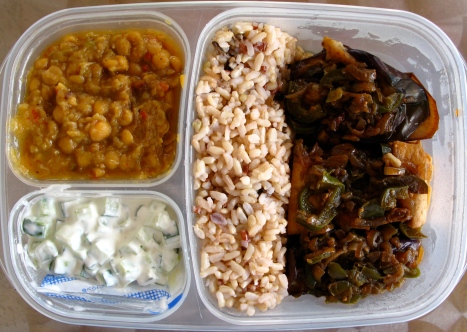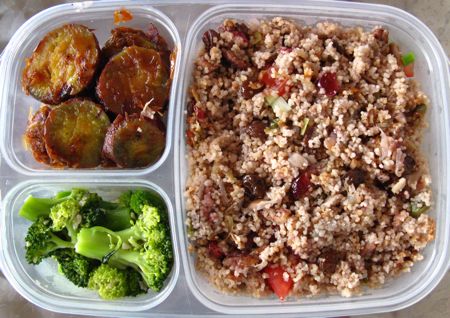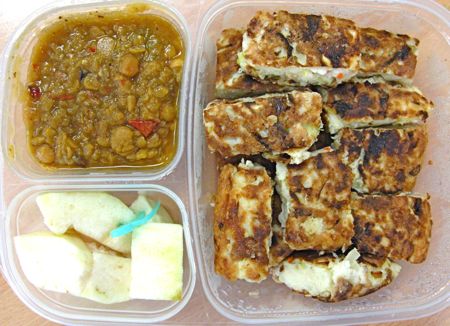
I’m back on the anti-candida diet so that means no more sweet snacks for the time being. No matter what Sue Dengate says about the counter-productiveness of combining anti-candida with Failsafe diets, I’m trying! It seems pretty logical to stay off sugars that feed the growth of yeast in the body. I think I’m experienced enough at trying to manage both individually to attempt to do both together. Recently I had to make a series of bento that were suitable for a vegetarian environment. Now that’s a major creativity challenge (admittedly, I didn’t keep to either an anti-candida or Failsafe diet strictly for that whole series of vegetarian bento :P)!
Frustrated with the less-than-satisfactory muffin results of my last batch (see the update on Green tea, azuki bean and pine nut muffins), I decided to make some apple muffins, which were my fortnightly staple — alternating with scones — when I was following the anti-candida diet a few years ago. Apples provide flavour and a hint of sweetness, and I’ve even had friends unable to detect the complete absence of sugar.
This time I decided to try something a little different. Have been thinking of trying a buttermilk muffin recipe for some time, hoping that the buttermilk will provide a bit more lift in the batter. It just so happened that I came across one in an Ayurvedic vegetarian cookbook I recently picked up, Heaven’s Banquet by Miriam Kasin Hospodar. I like the detailed explanations about each category of recipes, the thorough background information makes this book much better than simply a collection of recipes. The book has a half page on the ‘The Seven Pillars of Eggless Muffin Wisdom’, the last being that ‘eggless muffins become leaden and clunky if they sit too long, so it is best to bake them just before serving’. That didn’t sound so good to me, especially after suffering heavy gummy muffins of late, so I decided to keep the 1 egg I have been using all along, but adapt the instructions for including buttermilk+bicarbonate of soda (which react with each other, as I explained here).
I also made soya bean milk yesterday, with okara as a by-product, so I added in a handful of dried okara into the flours. This is supposed to help produce a lighter texture.
Ingredients
1 cup wholemeal flour
1 cup plain flour
handful of okara
1 tsp baking powder
3/4 tsp bicarbonate of soda
cinnamon, generous sprinkle (approx. 1 tsp?)
1 apple, chopped
3/4 cup yoghurt [to replace buttermilk; there’s a large tub of yoghurt with live cultures in my fridge to assist in the anti-candida diet]
1 cup soya bean milk
1 egg
1/4 cup oil
1) Sift dry ingredients together.
2) Toss apple bits in flour mixture.
3) Mix together wet ingredients.
4) Put all of the dry ingredients into wet mixture. Combine quickly till just mixed, about 15 strokes. Over-mixing will produce a heavy muffin.
5) Bake in preheated oven. I made it hotter than the 180℃, which I used to use, by using the ‘fan bake’ function. Hospodar’s muffin recipe recommends 200℃. Bake until golden brown and fragrant, 20-30 mins. I had a really big apple so there were lots of apple bits that made the surrounding batter soft and wet, even when the muffins were done, so skewers didn’t come out clean but upon dissecting a muffin, they seemed to be ready.
Recently, for some reason I seem to have lost my ability to determine whether something in the oven is done. The baking instructions never seem to be right and skewers come out clean but they aren’t done, or skewers are not clean but they seem ready. I’m beginning to wonder about the temperature control in my rather old oven; will have to invest in an oven thermometer. Another problem is having the baking trays on different racks on the oven, necessitating switching them around half way to ensure even baking. This never works for me though – the lower rack inevitably gets less heat at the all-important initial rising period so that tray is always not as good. I also must start paying more attention to my bakeware as dark and silver surfaces produce different results.

You can see an airy texture inside, without large tunneling or the gummy texture of the green tea muffins.
But guess what, I forgot to crush the dried okara chunks into a fine powder texture, so I ended up with these dry airy bits inside (the white part in the centre of photo). Okara is tasteless and I don’t really notice these dry chunks, but they don’t really add anything to the muffin, so it would be better to have all the okara crushed into a coarse grain instead.
To serve these sugarless muffins to friends and family with more conventional tastes, I cut a small hollow in the centre of each muffin and filled it with jam or marmalade.

I often don’t use paper cases because it’s wasteful and unnecessary. In this case, I wanted to make the muffins more presentable to give to friends, and also I used the paper cases to measure out smaller muffins (as compared to the giant size of normal muffin tins). I have a stack of 1000 paper cases to use up anyway (yes, that is the standard pack size in baking stores, or you can get packs of a few tens for an exorbitant price at supermarkets).
One problem of paper cases is that some of the muffin will stick to the paper. Muffins stick to the paper cases much more when they are hot; at room temperature, the paper cases will peel off relatively nicely, though there is the small problem of paper fibres sticking to the muffin (rather than bits of muffin sticking to the paper). [29/6/08 update: the more expensive glazed paper cases have less muffin sticking to them; they usually come in black or dark brown (think of the cases for expensive chocolates).]
Filed under: anti-candida diet, baking, food intolerance, recipes, sugar-free, wholemeal | Tagged: beans, soy (黄豆), cakes & muffins, eggs, flour, wheat, milk, non-dairy | Leave a comment »

























